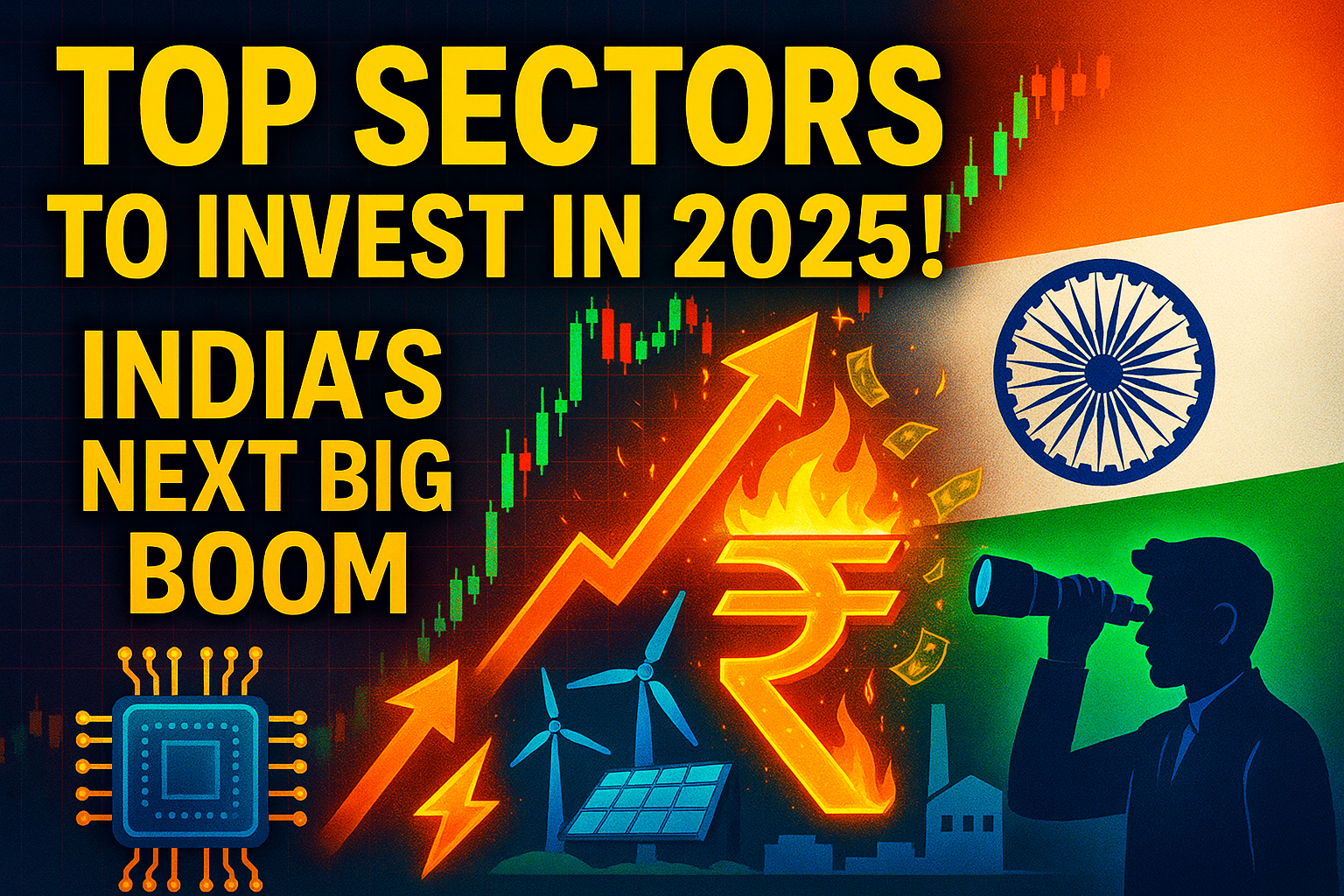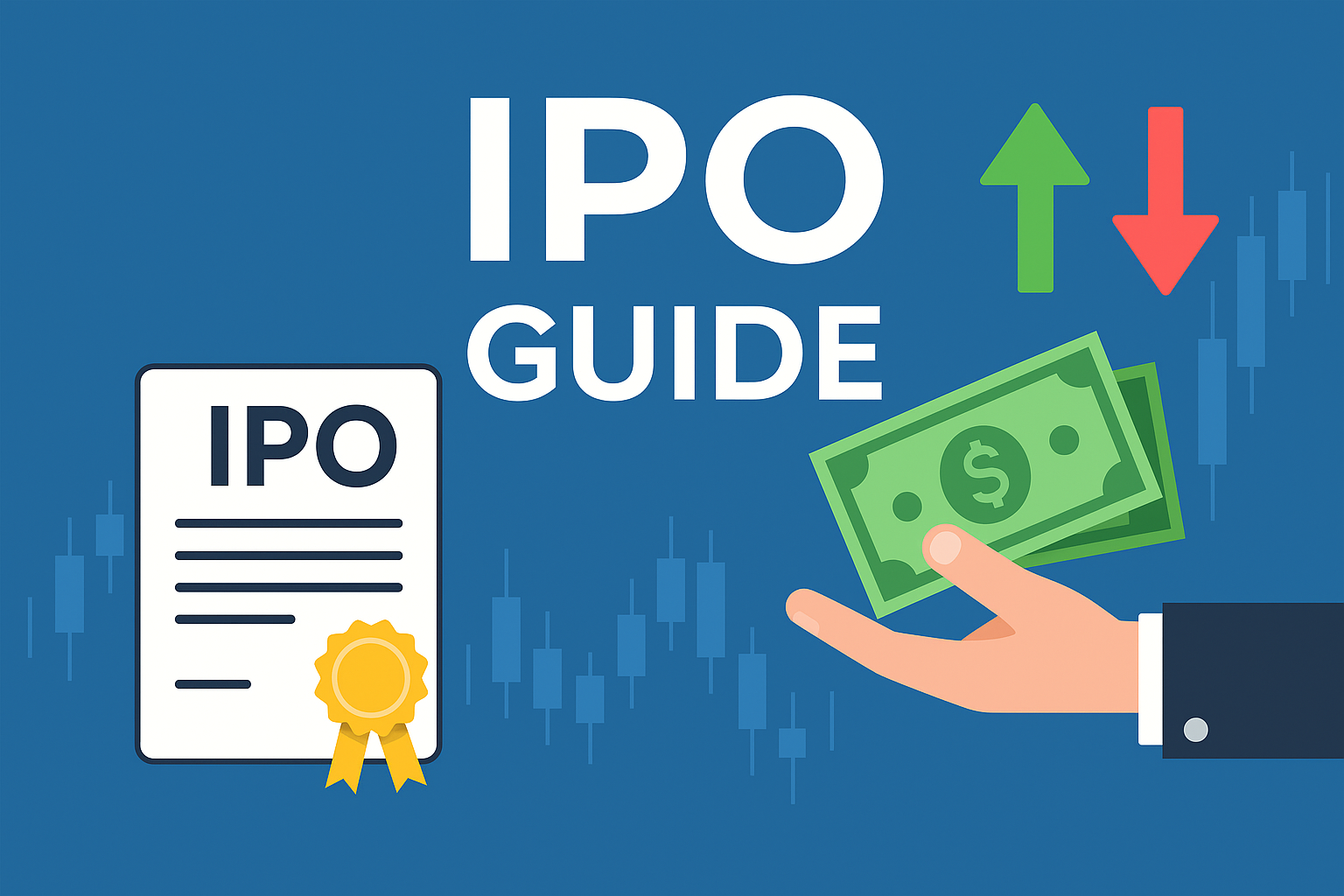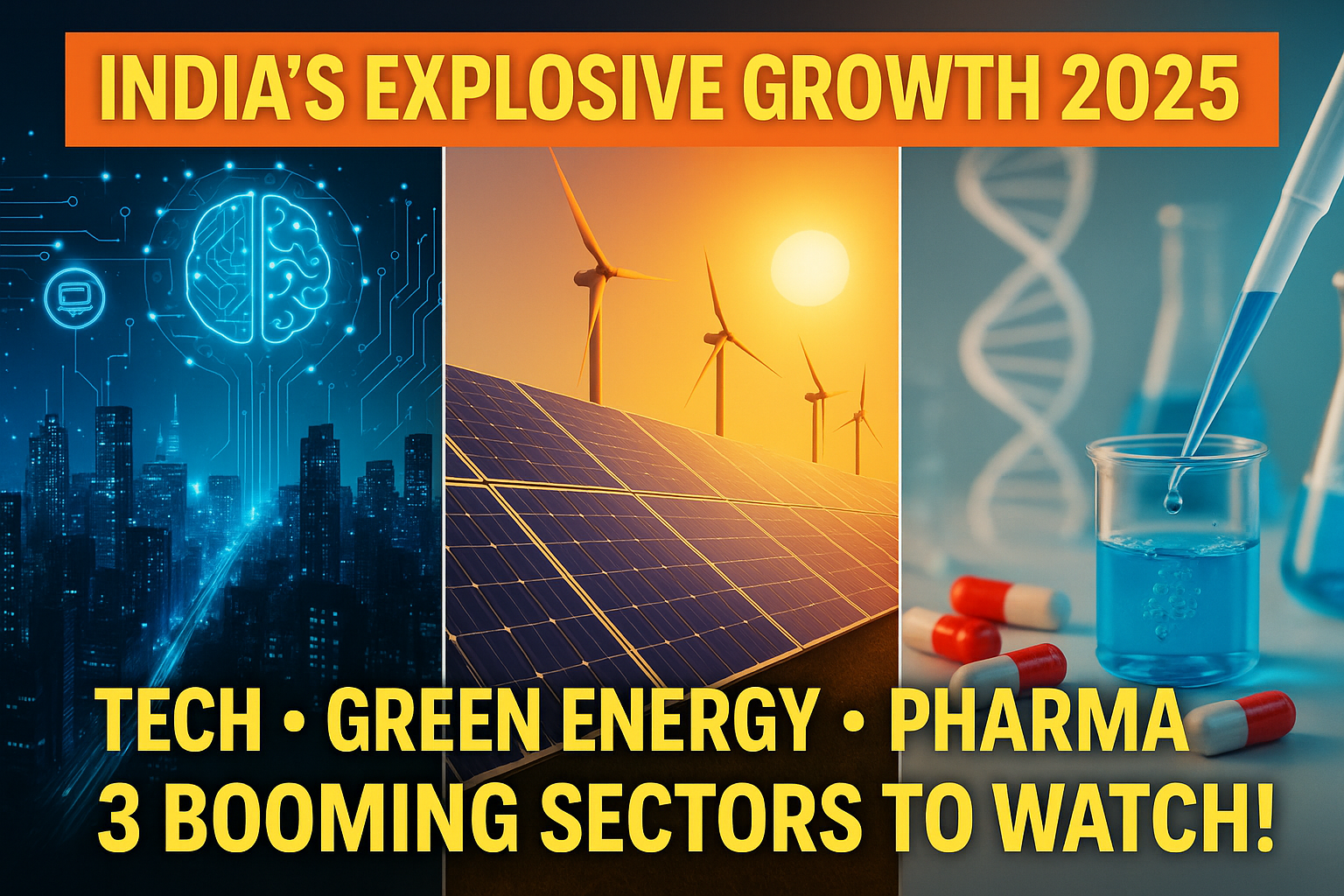In India’s dynamic 2025 market, several sectors are poised for significant growth, driven by technological advancements and shifting economic landscapes. The Technology and IT sector is expected to lead the way with a 15-20% CAGR, driven by digital adoption, 5G rollout, and AI integration.

According to ICICIdirect, the IT sector is growing faster than ever, driven by global digital shift, AI, Big Data & IoT, and remote work culture. Other high-growth sectors include Renewable Energy with an 18-25% CAGR and Pharma/Healthcare with a 12-18% CAGR.
As we navigate through 2025, understanding these sectors can help investors make informed decisions. Start your sectoral investing journey for 2025—explore the latest trends and top stocks now!
Key Takeaways
- Technology and IT sector expected to grow at 15-20% CAGR in 2025.
- Renewable Energy sector poised for 18-25% CAGR.
- Pharma/Healthcare sector to grow at 12-18% CAGR.
- Digital adoption and AI integration driving IT sector growth.
- Investors can capitalize on these trends for high returns in 2025.
The Economic Landscape of India in 2025
India’s economic landscape in 2025 will be shaped by its current indicators and future projections. The country is poised to continue its growth trajectory, driven by various domestic and global factors.
Current Economic Indicators and Future Projections
India’s GDP growth is projected to exceed 6.3% in 2025, driven by increased domestic consumption and infrastructure spending. According to recent reports, this growth is expected to be robust, supported by government initiatives and a rise in consumer spending.
Key Economic Indicators:
| Indicator | 2024 Projection | 2025 Projection |
|---|---|---|
| GDP Growth Rate | 6.0% | 6.3% |
| Inflation Rate | 4.5% | 4.2% |
| Unemployment Rate | 6.8% | 6.5% |
As noted by the International Monetary Fund (IMF), “India is expected to remain one of the fastest-growing major economies in 2025.” This projection underscores the potential for continued economic expansion.
“India’s economic growth story is being driven by a combination of factors, including government policies, technological advancements, and changing consumer behavior.”
India’s Position in the Global Investment Market
India is increasingly becoming an attractive destination for global investors. The country’s position in the global investment market is strengthening due to its large consumer base, growing digital economy, and favorable investment policies.
Factors Driving India’s Economic Growth
Several factors are driving India’s economic growth, including government initiatives, consumer behavior, and technological advancements. The government’s focus on infrastructure development, digitalization, and ease of doing business is creating new opportunities for growth.
- Government Initiatives: Policies like the Production-Linked Incentive (PLI) scheme are boosting manufacturing and attracting foreign investment.
- Consumer Behavior: Rising disposable incomes and changing consumer preferences are driving demand for goods and services.
- Technological Advancements: The adoption of digital technologies is transforming industries and creating new opportunities for businesses.
As India continues to grow, its economic landscape in 2025 will be characterized by robust growth, driven by a combination of domestic and global factors.
Why Sectoral Investing Matters for Maximum Returns
In the ever-changing landscape of India’s economy, sectoral investing emerges as a key strategy for maximizing returns. By focusing on specific sectors, investors can capitalize on emerging trends and growth opportunities, providing a strategic edge in the market.
Enhanced Stability During Market Fluctuations
Sectoral investing allows investors to diversify their portfolios across various sectors, reducing the risk associated with market volatility. By concentrating investments in sectors that are less correlated with overall market movements, investors can achieve a more stable return profile.
Benefits of Enhanced Stability:
- Reduced portfolio risk
- Protection against market downturns
- Consistent returns over time

Higher Return Potential Through Focused Investments
By investing in high-growth sectors, investors can tap into the potential for higher returns. Sectors such as technology and renewable energy are experiencing rapid growth, driven by innovation and government support.
| Sector | Growth Rate | Key Drivers |
|---|---|---|
| Technology | 15-20% CAGR | Digital adoption, 5G rollout, AI integration |
| Renewable Energy | 18-25% CAGR | Government incentives, global ESG focus |
Strategic Alignment with Future Economic Trends
Sectoral investing enables investors to align their portfolios with future economic trends. By identifying sectors poised for growth, investors can position themselves to benefit from long-term structural changes in the economy.
The future of India’s economy is likely to be shaped by sectors such as technology, renewable energy, and healthcare, driven by government initiatives and global trends.
India’s Hottest Sectors 2025: Where to Invest for Explosive Returns!
With a rapidly evolving economy, India is set to witness explosive returns in several sectors in 2025. The country’s economic landscape is transforming, driven by innovation, government initiatives, and a growing consumer base. Investors looking to capitalize on this growth need to focus on the top-performing sectors that are poised to deliver substantial returns.
Overview of Top-Performing Sectors
India’s economy in 2025 is expected to be driven by a mix of traditional and emerging sectors. The Technology sector continues to be a significant contributor, with a focus on digital transformation, AI, and 5G technology. Renewable Energy is another sector gaining momentum, driven by government incentives and a global shift towards sustainable energy. The Pharma/Healthcare sector is also witnessing robust growth, fueled by innovation in healthcare services and a strong export market.
Comparative Growth Rate Analysis
A comparative analysis of the growth rates of these sectors reveals some interesting trends. The IT sector is expected to grow at a CAGR of 15-20%, driven by increasing demand for digital services. Renewable Energy is projected to grow even faster, with a CAGR of 18-25%, as India continues to invest in sustainable energy solutions. The Pharma/Healthcare sector is anticipated to grow at a CAGR of 12-18%, supported by a strong pipeline of new drugs and healthcare innovations.
- Technology Sector: 15-20% CAGR
- Renewable Energy: 18-25% CAGR
- Pharma/Healthcare: 12-18% CAGR
Sectoral Contribution to India’s GDP
The contribution of these sectors to India’s GDP is significant and growing. The Technology sector alone accounts for a substantial portion of the country’s GDP, with the IT industry being a major driver. Renewable Energy is increasingly contributing to the GDP, as investments in solar and wind energy continue to rise. The Pharma/Healthcare sector also plays a crucial role, with exports and domestic consumption driving its growth.
Understanding the growth rates and GDP contributions of these sectors can help investors make informed decisions. By focusing on the hottest sectors in 2025, investors can position themselves for substantial returns in India’s rapidly evolving economy.
Technology and IT Sector: The Digital Revolution Continues
The Technology and IT sector in India is poised for significant growth in 2025, driven by the digital revolution. This sector has been a cornerstone of India’s economy, contributing substantially to the country’s GDP and export earnings.

Growth Projections and 15-20% CAGR Potential
India’s Technology and IT sector is expected to witness a Compound Annual Growth Rate (CAGR) of 15-20% in 2025. This growth is attributed to the increasing demand for digital services, the adoption of emerging technologies like AI and IoT, and the expansion of the global delivery model.
Key factors driving this growth include:
- Increasing digital adoption across industries
- Rapid rollout of 5G technology
- Integration of Artificial Intelligence (AI) in business processes
Key Drivers: Digital Adoption, 5G Rollout, and AI Integration
The digital transformation across industries is a significant driver for the IT sector. With the advent of 5G technology, there is a heightened demand for high-speed data processing and low-latency applications. Moreover, AI integration is enhancing business efficiency and opening new avenues for innovation.
The impact of these drivers is evident in the growing demand for IT services, including cloud computing, cybersecurity, and data analytics.
Top Companies to Watch: Infosys, TCS, and Emerging Players
Established players like Infosys and TCS are leading the way in the Indian IT sector. These companies are not only driving growth through their traditional services but are also at the forefront of adopting new technologies.
| Company | Key Strengths | Growth Prospects |
|---|---|---|
| Infosys | Digital transformation, AI, and cloud services | High growth potential in digital services |
| TCS | BFSI, retail, and manufacturing services, AI, and IoT | Strong growth prospects in BFSI and retail |
| Emerging Players | Innovative solutions, niche services | Potential for rapid growth through innovation |
In conclusion, the Technology and IT sector in India is set for robust growth in 2025, driven by digital adoption, 5G rollout, and AI integration. Investors should keep a close eye on established players like Infosys and TCS, as well as emerging companies that are innovating and disrupting the market.
Renewable Energy: Powering India’s Sustainable Future
The renewable energy sector in India is on the cusp of a revolution, driven by government initiatives and a global shift towards sustainable energy sources. As the world moves towards reducing carbon emissions and combating climate change, India’s commitment to renewable energy is becoming increasingly significant.
18-25% CAGR Expectations
The renewable energy sector in India is projected to grow at a Compound Annual Growth Rate (CAGR) of 18-25% in the coming years. This growth is driven by the declining costs of renewable energy technologies, making them more competitive with fossil fuels. The government’s ambitious targets for renewable energy capacity addition are also a significant driver.
Key Growth Drivers:
- Government incentives and subsidies
- Increasing demand for clean energy
- Technological advancements in renewable energy
- Global ESG (Environmental, Social, and Governance) focus
Government Incentives and Global ESG Focus
Government incentives play a crucial role in promoting the renewable energy sector. Initiatives such as tax exemptions, subsidies, and the viability gap funding scheme are encouraging investments in renewable energy projects. Additionally, the global focus on ESG considerations is driving international investments into India’s renewable energy sector.
The convergence of government support and global ESG focus is creating a conducive environment for the growth of renewable energy in India.
Leading Companies: Tata Power, Adani Green, and Rising Stars
Several leading companies are at the forefront of India’s renewable energy revolution. Tata Power and Adani Green are among the top players, with significant investments in solar and wind energy projects. Emerging companies are also making a mark, driven by innovative technologies and business models.
| Company | Renewable Energy Capacity | Growth Plans |
|---|---|---|
| Tata Power | 4,000 MW | Expansion into new geographies |
| Adani Green | 5,000 MW | Focus on solar energy |
| Rising Stars | 1,000 MW | Innovative technology adoption |
The renewable energy sector in India is poised for significant growth, driven by government support, technological advancements, and global investments. As the sector continues to evolve, it is expected to play a critical role in India’s sustainable development journey.
Pharmaceutical and Healthcare: Innovation and Global Expansion
India’s pharmaceutical and healthcare sector is on the cusp of a new era, driven by advancements in healthcare innovation and increasing global demand. This sector is a significant contributor to India’s economy and is projected to grow at a CAGR of 12-18% in 2025.
Growth Projections and Outlook
The pharmaceutical and healthcare industry in India is expected to witness substantial growth, driven by factors such as increasing demand for healthcare services, advancements in medical technology, and a growing focus on research and development. The sector’s growth is further supported by government initiatives aimed at improving healthcare infrastructure and promoting innovation.
Growth Projections:
| Year | Growth Rate (%) | Market Size (USD Billion) |
|---|---|---|
| 2023 | 10 | 120 |
| 2024 | 12 | 134.4 |
| 2025 | 15 | 154.56 |
Key Drivers: Healthcare Innovation, R&D, and Export Markets
The growth of the pharmaceutical and healthcare sector is driven by several key factors, including:
- Healthcare Innovation: Advancements in medical technology and innovative treatment options are driving growth in the sector.
- Research and Development (R&D): Increased focus on R&D is leading to the development of new drugs and therapies, further boosting the industry.
- Export Markets: India’s pharmaceutical exports are on the rise, with the country emerging as a significant player in the global market.
Top Performers: Sun Pharma, Cipla, and Emerging Biotech Firms
Some of the top performers in the Indian pharmaceutical and healthcare sector include:
- Sun Pharma: One of the largest pharmaceutical companies in India, known for its innovative products and global presence.
- Cipla: A leading player in the Indian pharmaceutical industry, Cipla is recognized for its high-quality products and commitment to healthcare.
- Emerging Biotech Firms: Several emerging biotech companies are making significant contributions to the sector, driving innovation and growth.

Other Promising Sectors for 2025
As we approach 2025, several sectors in India are emerging as promising investment opportunities. Beyond the top-performing sectors, other industries are expected to drive growth in India’s economy.
Financial Services and Fintech Revolution
The financial services sector, including fintech, is undergoing a significant transformation. Digital payment systems, online lending platforms, and robo-advisory services are becoming increasingly popular. The fintech market in India is expected to grow at a CAGR of 20% from 2023 to 2025, driven by government initiatives and technological advancements.
Electric Vehicles and Auto Component Manufacturing
The electric vehicle (EV) sector is gaining momentum in India, driven by government incentives and a growing demand for eco-friendly transportation. Auto component manufacturing is also expected to benefit from the EV boom, with companies shifting focus to produce EV-specific parts.
E-commerce and Digital Consumer Services
E-commerce continues to be a significant growth driver in India, with online shopping becoming increasingly popular among consumers. Digital consumer services, including online food delivery and streaming services, are also expected to see substantial growth.
Manufacturing and Production-Linked Incentive Beneficiaries
The Indian government’s Production-Linked Incentive (PLI) schemes are expected to boost manufacturing across various sectors, including electronics, pharmaceuticals, and automobiles. Companies that benefit from these schemes are likely to see significant growth in 2025.
These promising sectors offer attractive investment opportunities for those looking to capitalize on India’s economic growth in 2025.
Government Initiatives Fueling Sectoral Growth
Government initiatives play a pivotal role in shaping India’s economic landscape and fostering sectoral growth. The Indian government has introduced several policies and reforms aimed at promoting economic development and attracting investments.
Recent Policy Changes and Their Market Impact
Recent policy changes have been instrumental in driving sectoral growth. For instance, reforms in labor laws and land acquisition policies have made it easier for businesses to operate in India. These changes have positively impacted the market, leading to increased investor confidence.
The government’s focus on ease of doing business has resulted in India improving its ranking in the World Bank’s Doing Business Report. This improvement is a testament to the effectiveness of the government’s initiatives.
Production-Linked Incentive (PLI) Schemes
The Production-Linked Incentive (PLI) Schemes are a key initiative aimed at promoting domestic manufacturing. The scheme offers incentives to companies that set up or expand their manufacturing operations in India. This has led to a surge in investments in sectors like electronics, pharmaceuticals, and automobiles.
- Incentives for manufacturing sectors
- Boost to domestic production
- Attracting foreign investments
Foreign Direct Investment (FDI) Reforms
The government has implemented several FDI reforms to attract foreign investments. These reforms include relaxing FDI norms in various sectors, making it easier for foreign companies to invest in India. The result has been a significant increase in FDI inflows, contributing to sectoral growth.
Key FDI Reforms:
- Relaxation of FDI norms in key sectors
- Simplification of investment procedures
- Enhanced investor protection
Digital India and Other Transformative Programs
The Digital India initiative is a flagship program aimed at transforming India into a digitally empowered society. The program focuses on digital infrastructure development, digital literacy, and delivering government services electronically. This initiative has had a profound impact on various sectors, including education, healthcare, and financial services.

The government’s commitment to digital transformation is evident in its efforts to promote digital payments, e-governance, and digital literacy. These initiatives are expected to drive sectoral growth and create new opportunities for businesses.
Step-by-Step Guide to Investing in India’s High-Growth Sectors
The Indian market presents a compelling case for investment, driven by its high-growth sectors and increasing global influence. As investors look to tap into this potential, understanding the steps involved in investing in India’s high-growth sectors is crucial.
Opening a Demat/Trading Account for International Investors
For international investors, the first step in investing in Indian stocks is opening a Demat and trading account. A Demat account holds shares in electronic form, while a trading account allows for the buying and selling of securities.
Steps to Open a Demat/Trading Account:
- Choose a registered Depository Participant (DP) or a brokerage firm that offers Demat and trading services.
- Fill out the account opening form, providing necessary KYC (Know Your Customer) documents.
- Submit the required documents, which typically include proof of identity, proof of address, and PAN (Permanent Account Number) card.
- Sign the agreement and await account activation.
Using Stock Screeners to Identify High-Potential Stocks
Stock screeners are powerful tools that help investors identify high-potential stocks based on specific criteria such as market capitalization, sector, and growth metrics.
Key Features to Look for in a Stock Screener:
- Customizable filters to narrow down stocks based on investment criteria.
- Real-time data to ensure that the information is current.
- User-friendly interface for ease of use.
Diversification Strategies Across Multiple Sectors
Diversification is a key investment strategy that involves spreading investments across various sectors to mitigate risk.
| Sector | Growth Potential | Key Companies |
|---|---|---|
| Technology | High | Infosys, TCS |
| Renewable Energy | Very High | Tata Power, Adani Green |
| Pharmaceuticals | High | Sun Pharma, Cipla |
Implementing Systematic Investment Plans (SIPs)
SIPs allow investors to invest a fixed amount of money at regular intervals, providing a disciplined approach to investing.
Benefits of SIPs:
- Rupee cost averaging, reducing the impact of market volatility.
- Compounding benefits over the long term.
- Flexibility to invest varying amounts.
By following these steps and strategies, investors can effectively tap into India’s high-growth sectors and potentially achieve significant returns on their investments.
Risk Factors and Challenges to Consider
As India’s economy continues to grow, understanding the risk factors associated with its high-growth sectors becomes increasingly important. Investors must consider various challenges that can impact their investments.
Regulatory Changes and Political Considerations
India’s regulatory landscape is dynamic, with frequent changes in policies and laws affecting various sectors. For instance, changes in tax policies or labor laws can significantly impact the profitability of investments. Political considerations, including election outcomes and government stability, also play a crucial role in shaping the investment climate.
- Changes in tax policies can affect profit margins.
- Labor law reforms can impact operational costs.
- Election outcomes can influence market sentiment.
Global Economic Influences on Indian Markets
Indian markets are not isolated from global economic trends. Global events, such as economic downturns in major economies or shifts in international trade policies, can have a ripple effect on Indian markets. Investors need to stay informed about global economic indicators and trends.
- Global economic downturns can reduce demand for Indian exports.
- Trade policy changes can affect the competitiveness of Indian industries.
- Fluctuations in global commodity prices can impact inflation and interest rates.
Sector-Specific Risks and Mitigation Strategies
Different sectors in India come with their unique set of risks. For example, the technology sector faces risks related to data privacy and cybersecurity, while the renewable energy sector is exposed to risks associated with policy changes and technological advancements. Understanding these risks and implementing mitigation strategies is crucial.
Mitigation Strategies:
- Diversification across sectors.
- Regular monitoring of regulatory changes.
- Investing in companies with strong governance and risk management practices.
Currency Fluctuation Impacts for US-Based Investors
For US-based investors, currency fluctuations between the Indian Rupee (INR) and the US Dollar (USD) can impact investment returns. A depreciating INR can reduce the value of investments when converted back to USD.
Strategies to manage currency risk include:
- Investing in companies with a natural hedge against currency fluctuations.
- Using financial instruments like futures and options to hedge against currency risks.

Conclusion: Building Your High-Return Portfolio for 2025
Building a high-return portfolio for 2025 requires a deep understanding of India’s high-growth sectors, including Technology, Renewable Energy, and Pharma/Healthcare. By diversifying across multiple sectors and staying informed about market trends, investors can create a robust high-return portfolio.
A well-diversified portfolio can help mitigate risks and capitalize on emerging opportunities. Investors should consider the associated risk factors, including regulatory changes and global economic influences, to make informed decisions.
To achieve significant returns, investors can leverage government initiatives, such as Production-Linked Incentive (PLI) schemes and Foreign Direct Investment (FDI) reforms, which are driving sectoral growth. By staying up-to-date with market trends and adjusting their investment strategies accordingly, investors can build a high-return portfolio poised for success in 2025.
FAQ
What are the best sectors for high returns in India in 2025?
The top sectors for high returns in India in 2025 are Technology, Renewable Energy, and Pharma/Healthcare, driven by factors such as digital adoption, government incentives, and healthcare innovation.
How can I invest in India’s high-growth sectors?
To invest in India’s high-growth sectors, you can open a Demat/trading account, use stock screeners to identify high-potential stocks, diversify across multiple sectors, and implement Systematic Investment Plans (SIPs).
What is the growth rate of the Technology and IT sector in India in 2025?
The Technology and IT sector in India is expected to grow at a 15-20% CAGR in 2025, driven by digital adoption, 5G rollout, and AI integration.
What are the key drivers behind the growth of the Renewable Energy sector in India?
The key drivers behind the growth of the Renewable Energy sector in India are government incentives and global ESG focus, with a projected growth rate of 18-25% CAGR in 2025.
Are pharma companies a good investment in India in 2025?
Yes, pharma companies are a good investment in India in 2025, with the Pharmaceutical and Healthcare sector expected to grow at a 12-18% CAGR, driven by healthcare innovation, R&D, and export markets.
What are the other promising sectors for investment in India in 2025?
Other promising sectors for investment in India in 2025 include Financial Services, Electric Vehicles, E-commerce, and Manufacturing, driven by factors such as fintech revolution, government incentives, and digital consumer services.
How do government initiatives impact sectoral growth in India?
Government initiatives such as Production-Linked Incentive (PLI) Schemes, Foreign Direct Investment (FDI) Reforms, and Digital India program have a significant impact on sectoral growth in India, driving investment and innovation.
What are the risk factors to consider when investing in India’s high-growth sectors?
The risk factors to consider when investing in India’s high-growth sectors include regulatory changes, political considerations, global economic influences, sector-specific risks, and currency fluctuation impacts.
How can I mitigate risks when investing in India’s high-growth sectors?
To mitigate risks, you can diversify your portfolio across multiple sectors, stay informed about market trends, and consider implementing risk management strategies such as hedging against currency fluctuations.










